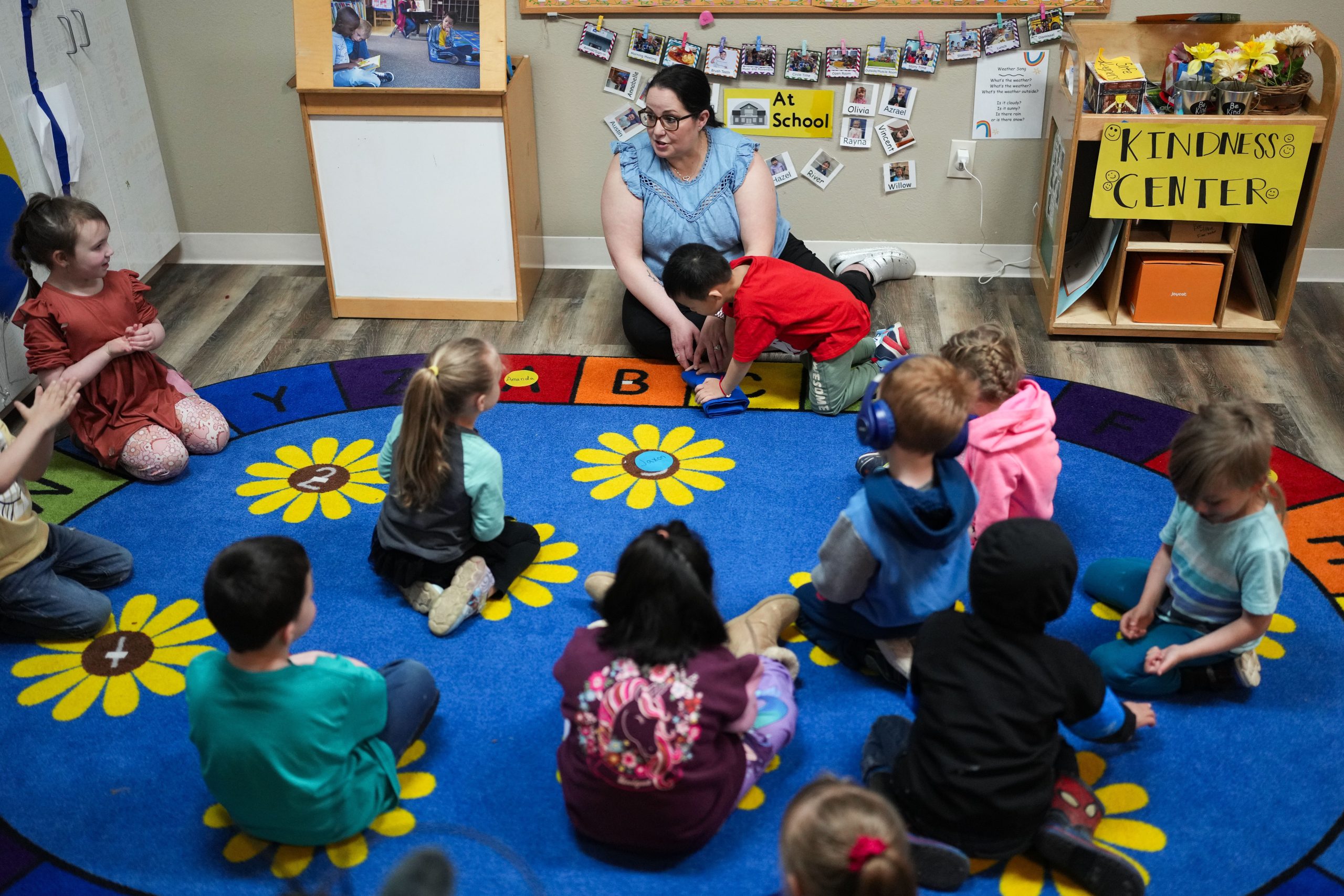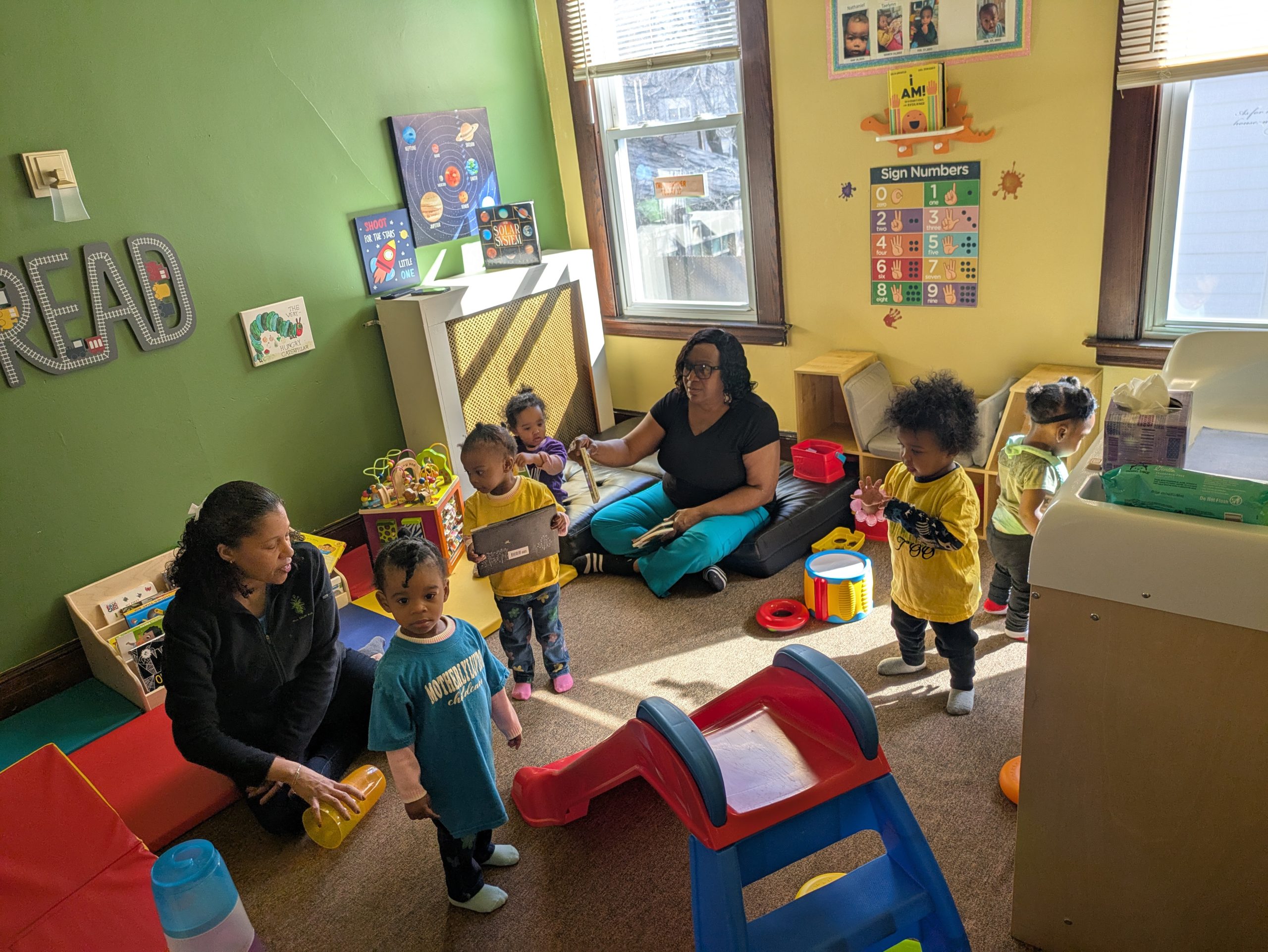by Jackie Mader, The Hechinger Report
November 1, 2025
The first hint of trouble for McKinley Hess came in August.
Hess, who runs an infant and toddler care program in Conway, Arkansas, heard that the teen moms she serves were having trouble getting their expected child care assistance payments. Funded by a mix of federal and state dollars, those subsidies are the only way many low-income parents nationwide can afford child care, by reimbursing providers for care and lowering the amount parents have to pay themselves.
In Arkansas, teen parents have long been given priority to receive this aid. But now, Hess heard, they and many other families in need were sitting on a growing wait-list.
Hess had just enrolled eight teen moms at her central Arkansas site, Conway Cradle Care, and was counting on state subsidies to pay for their children’s care. As the moms were stuck waiting for financial assistance, Hess had two options: kick them out, or care for their infants for free so their mothers wouldn’t have to drop out of school. She chose the latter.
Just a month later, another hit: Arkansas government officials announced they were going to cut the rates they pay providers on behalf of low-income families. Beginning Nov. 1, Hess will get $36 a day for each infant in her care and $35 a day for toddlers, down from $56 and $51 a day respectively. She’s already lost out on more than $20,000 by providing free care for 8 infants for the past two months.
“Financially, it really is going to hurt our day care,” Hess said. But the stakes are also high for the parents who need child care assistance, she said: “For them to be able to continue school, these vouchers are essential.”
As states face having to cut spending while bracing for fewer federal dollars under the budget bill President Trump signed in July, some, including Arkansas, view early learning programs as a place to slash funding. They’re making these cuts even as experts and providers predict they will be disastrous for children, families and the economy if parents don’t have child care and can’t work.
The same families face other upheaval: The ongoing government shutdown means states may not receive their Nov. 1 shares of federal money for the Supplemental Nutrition Assistance Program, also known as food stamps, meaning families may not get that aid. Across the country, more than 100 Head Start centers, part of a federally funded preschool program that provides free child care, may have to close, at least temporarily, if the shutdown drags on as expected and they do not get expected federal cash by the start of next month.
Related: Young children have unique needs and providing the right care can be a challenge. Our free early childhood education newsletter tracks the issues.
Elsewhere, Colorado, Maryland and New Jersey recently stopped accepting new families into their child care assistance programs. In June, Oregon’s Democratic-led legislature cut $20 million from the state’s preschool program for low-income families. In September, Indiana joined Arkansas in announcing reductions in reimbursement rates for providers who care for low-income children. This summer, the governor of Alaska vetoed part of the state’s budget that would have given more money to child care and early intervention services for young children with developmental disabilities. Washington state legislators cut $60 million last month from a program that provides early learning and family support to preschoolers. Additional cuts or delays in payments have cropped up in Ohio, Nevada and the District of Columbia.
“Almost every state is facing a very, very, very significant pullback of federal dollars,” said Daniel Hains, chief policy officer at the D.C.-based National Association for the Education of Young Children. “It does not help families when you cut provider reimbursement rates, when you cut funds going to providers, because it makes it less likely that those families are going to access the high-quality child care that they need.”
This trend could further devastate America’s fragile child care industry, which has been especially slow to recover since the pandemic due to a lack of funding. Child care programs are expensive to run and, with limited public support, providers rely heavily on tuition from parents to pay their bills.
In many parts of the country, parents already pay the equivalent of college tuition or a second mortgage on child care and have little ability to pay more. Yet child care staff generally make abysmally low wages and have high turnover rates. There’s often little wiggle room in program budgets.
One of the only sources of federal funding for child care centers comes from the federally funded Child Care and Development Fund. Each year, Congress sets the level of block grants to states, which add matching funds. Arkansas officials said recent cuts to their subsidy program are in response to an unexpected $8 million decrease in federal CCDF funding this year after post-pandemic changes to the way state payouts are calculated.
In September, Arkansas Secretary of Education Jacob Oliva told lawmakers that without cutting rates to providers, the state would be unlikely to be able to sustain the program. “The last thing I want to do is set up a reimbursement rate that at Christmas we have to call everybody and say we’re done, we spent all our money,” he said during a hearing.
In addition to cutting payments to providers, the state increased family co-payments, the amount parents must pay toward child care in addition to what their subsidy covers. It’s far from a perfect solution, Oliva told lawmakers. “But we have to do something.”
Related: How early ed is affected by federal cuts
During the pandemic, child care programs and states received a fresh infusion of public funds from the American Rescue Plan Act and the Child Care and Development Block Grant, helping to stabilize those businesses. Many states used the influx to bolster their subsidy programs, allowing more children to use them and increasing what providers were paid.
As that aid expired over the last two years, some states found money to sustain that expansion, but others did not. Indiana was left with a $225 million gap between the cost of its child care subsidy program and the state money dedicated to filling it. In October, officials cut reimbursement rates by 10 to 35 percent, saying in a statement that “there is only one pot of money — we could either protect providers or kids, and we chose kids.”
Experts and child care directors say, however, that in the child care business it’s impossible to decouple kids from providers. The decision to cut reimbursement rates will ultimately hurt both, they insist, especially as providers find it hard to keep their doors open. Already, some programs have shuttered or announced plans to close by the end of the year. At others, families have left in search of more affordable care.
Cori Kerns, a senior staff consultant at Little Duckling Early Learning Schools in Indianapolis, said that now that schools are receiving less money from the state, parents must make up the difference. Since the changes were announced in September, Little Duckling has lost 26 children — nearly 18 percent of its enrollment — because parents cannot afford that increase.
“That could be a tank of gas to them, that could be some groceries, that could be school supplies or medical needs. Some of them have had to literally stop and stay home with their child in order to survive and also not pay for child care,” Kerns said. “Those kids are suffering” as they stay home with stressed parents who are worrying about lost income, she added.
As families pulled their children, Kerns merged two buildings of her program into one, creating larger class sizes and new teacher assignments. That’s led to challenging behavioral problems for children who must adjust to new environments. Kerns anticipates losing teachers now that the work environment has become more stressful.
Experts warn this trend in some states of scaling back early childhood investments is widening an existing nationwide disparity in the availability of affordable, high-quality child care. While states like Arkansas and Indiana pull back, a handful of others are moving the opposite direction, putting more money toward early learning. In New Mexico, for example, the nation’s first free universal child care program will launch on Nov. 1, paid for by oil and gas revenue that is routed to the state’s Early Childhood Education and Care Fund. In 2023, Vermont passed a payroll tax to increase child care funding in the state, while Connecticut established an endowment this year to route surplus state funds into early learning programs.
States have already been diverging in their approach to the child care industry since the pandemic. Rather than invest in more qualified workers, some states have opted to deregulate child care and bring teenagers in to care for young children. At the same time, places like the District of Columbia have increased qualifications for child care providers.
Related: Rural Americans rely on Head Start. Federal turmoil has them worried
“This is what happens when you don’t have public federal dollars in the system,” said NAEYC’s Hains. In states that are clawing back child care funds, “it’s going to result in lower quality care for children, or it’s going to result in families pulling back from the workforce and facing greater economic insecurity,” Hains said. “We’re going to see a real harmful impact on children and families as these investments are pulled back.”
In Mooresville, Indiana, Jen Palmer calculated that her program, The Growing Garden Learning Center, will lose about $260,000 from its annual budget because of cuts in state contributions to care for children from low-income families.
“If nothing changes as of today, I can sustain for a year,” Palmer said. “Past that, I’m going to start dipping into my retirement savings.” She’s hesitant to discuss closing the program, one of highest-quality centers in the area. “I believe in this place. What we do is amazing. We just have to make it through this.”
The lower subsidy rate is just the latest of a series of changes that Palmer has endured. Last December, Indiana stopped accepting new applicants into the care aid program and instead launched a waiting list. Palmer stopped getting calls from parents who wanted to enroll their children, as they couldn’t pay for care on their own.
Earlier this year, Indiana also announced cuts to reimbursement rates for its pre-K program, which is run in schools and child care programs throughout the state. Palmer now receives about $148 a week for each pre-K student she serves, down from more than $300 a week last year. Over the past three months, she’s had to lay off seven teachers and has taken over teaching in a pre-K classroom in the mornings. “We’re going to do our darndest that the kids don’t feel the impact,” she said.
She hasn’t been able to completely shield them. One toddler in her program recently shocked and delighted his teachers when he said his first word in English: a bold “no.” Concerned that the child had language delays, they were thrilled that he was starting to make progress.
Then the child’s family pulled him out of the program. His mother, who works as a delivery driver, had previously qualified for free child care paid for by state. With the state now paying less, her tuition jumped to $167 a month.
Instead of interacting with other children and teachers, playing and learning new skills, the toddler is now “sitting in mom’s car in a car seat driving around all over the county while she delivers for Uber,” said Palmer. “That just set that little guy years back. When he enters school, he’s no longer going to be on par with his classmates. That’s not fair. That can’t be the answer.”
Contact staff writer Jackie Mader at 212-678-3562 or [email protected]
This story about child care was produced by The Hechinger Report, a nonprofit, independent news organization focused on inequality and innovation in education. Sign up for the Hechinger newsletter.
This <a target=”_blank” href=”https://hechingerreport.org/child-care-crisis-deepens-as-funding-slashed-for-poor-families/”>article</a> first appeared on <a target=”_blank” href=”https://hechingerreport.org”>The Hechinger Report</a> and is republished here under a <a target=”_blank” href=”https://creativecommons.org/licenses/by-nc-nd/4.0/”>Creative Commons Attribution-NonCommercial-NoDerivatives 4.0 International License</a>.<img src=”https://i0.wp.com/hechingerreport.org/wp-content/uploads/2018/06/cropped-favicon.jpg?fit=150%2C150&ssl=1″ style=”width:1em;height:1em;margin-left:10px;”>
<img id=”republication-tracker-tool-source” src=”https://hechingerreport.org/?republication-pixel=true&post=113184&ga4=G-03KPHXDF3H” style=”width:1px;height:1px;”><script> PARSELY = { autotrack: false, onload: function() { PARSELY.beacon.trackPageView({ url: “https://hechingerreport.org/child-care-crisis-deepens-as-funding-slashed-for-poor-families/”, urlref: window.location.href }); } } </script> <script id=”parsely-cfg” src=”//cdn.parsely.com/keys/hechingerreport.org/p.js”></script>












